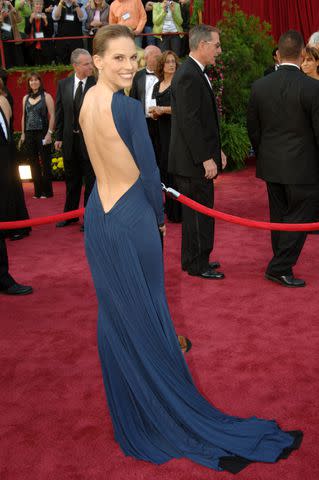Hilary Swank Wants to Slow Down Fast News and Fast Fashion
The 'Alaska Daily' star talks about the importance of local news, her slow fashion line, Mission Statement, and the story behind her famous Oscars dress.

BFA
Without missing a beat, Hilary Swank knows that people will see her new show, Alaska Daily, and presume it's just another "White Savior" storyline. She is, after all, playing a white journalist who finds herself embroiled in the cold case of a missing indigenous woman in Anchorage, Alaska, shortly after losing her job at a big city newspaper. The two-time Academy Award winner also knows that she has the opportunity to give viewers something very, very different — and it's exactly what she's doing. By bringing the stories of indigenous people to the forefront (in good company, she adds, with shows like Reservation Dogs and Rutherford Falls on the air), she knows that they can take the spotlight.
When asked about how the current distrust of the media plays into a show about a local newspaper, Swank doesn't hesitate to say that people can — and should — question where and how they get their news. She doesn't discredit social media entirely, either, but she does suggest that we all take a moment to dig a little deeper and go beyond what she calls "fast journalism."
"Fast journalism, to me, is kind of getting the information on Instagram. What would be a truth? I saw it on Instagram. It's scrolling and scrolling and scrolling and seeing things rather than digging into a journalist who has devoted their life to finding the truth," Swank says. "They are out there."

ABC
:
Swank's Eileen Fitzgerald is one of those journalists. The show, which premieres Oct. 6 on ABC, follows Fitzgerald as she investigates the stories that matter to a rural part of the country — one that's often overlooked in national news coverage. And as crimes against indigenous people make headlines in America and Canada, Swank assures viewers that the team at Alaska Daily is aware that the show is treading on sensitive territory.
"We have a couple of writers on our team that are ensuring that we're being inclusive in a way that isn't just from the perspective of a white person. That would be a huge injustice, a continued injustice to the storytelling in a real and hopefully powerful way that gets the truth out," she says of how Alaska Daily hopes to show the realities of indigenous people. "I think being able to shine a light on that and do it in a way that does justice," she adds. "Holding people accountable to follow through, which is what storytelling can do."
While major outlets may get all the applause when it comes to covering huge events (and the brunt of the criticism), Swank and the Alaska Daily team hope to bring local journalism a little more love. She says that without local publications, "many people don't see their communities represented in the media."
"It's talking about also how important local journalism is. It's not just talking about the New York Times and the Post," she continues. "We're talking about how local journalism matters, how a lot of the big conglomerate kind of news isn't going to cover the smaller things that matter and are important to a smaller hometown."
:
Just like fast news is a quick fix for people hoping to get their information as easily as possible, Swank says fast fashion can be just as detrimental long-term. Her apparel line, Mission Statement, hopes to slow things down and offer pieces that eschew the trend cycle and, instead, embrace longevity and craftsmanship.
"I read all about fast fashion. And I just read about finding something that is made well in heritage factories," Swank says of the manufacturing behind Mission Statement. "Our stuff is all made in the same factories that Chanel and Moncler are made in, but we make it at a quarter of the price because I don't like the idea that only a certain amount of people can buy that stuff because it's so expensive."
Swank isn't immune to self-criticism, however, saying that she knows that Mission Statement's knits, activewear, and loungewear aren't as affordable as fast fashion. Like ingesting news more thoughtfully, she wants consumers to take a beat and think about the intentions and processes behind the clothes they choose to buy and wear.
"At a quarter of the price, it's still not cheap [as fast fashion], but we're not looking for cheap. We're looking for quality and stuff that will last," she says. "When I read that people buy inexpensive clothing, fast fashion, and wear it two-and-a-half times or three times before throwing it away. They don't even give it away, because it's so cheap and it doesn't matter to them. We're just killing our environment with that."
It's impossible to speak to Swank about fashion without mentioning one of her most memorable outfits: the long-sleeved Guy Laroche gown she wore in 2005 when she won her second Best Actress Oscar for Million Dollar Baby. Swank said that after a not-so-great red carpet experience years prior, she was determined not to let it happen again — and actually snagged the dress at a photo shoot.
"The morning of the Academy Awards for Boys Don't Cry, I didn't have a dress, because it was such an awful experience with the stylist, and it was just like everything that could go wrong went wrong," she says. "So, I was like, 'That's not going to happen again.' So, for Million Dollar Baby, I was just able to get into it sooner. I knew what to expect. I knew I'd been down the road before. I had gone to a photo shoot for Italian Vogue or something."

Getty Images
Because even Oscar-winning actresses can't just walk off with whatever gowns they want, Swank says that she had to practically beg the team on set to take it with her, promising that a moment like the Academy Awards was the perfect place for the gown to be seen.
"I was going through their dress rack, and I saw it, and I was like, 'This is the dress I want to wear to the Academy Awards.' And they're like, 'OK, but you have to wear it for your photo shoot, too,'" Swank recalls. "And I'm like, 'No, no, it'll get photographed on the red carpet. I'm wearing it to the Academy Awards. And they're like, 'OK, well, we'll send it to you.'"
"I have to walk out with this dress right now because I'm afraid I'll never see it again," she remembers telling the crew. "But it's one of those moments when you put something on, and you're like, this is my dress. I feel it. I look good in it. I walk taller in it. This is it. And I love the color."

 Yahoo Movies
Yahoo Movies 
